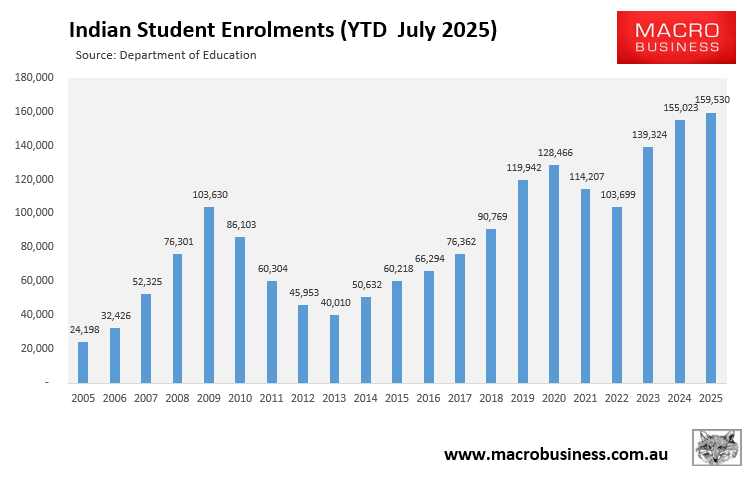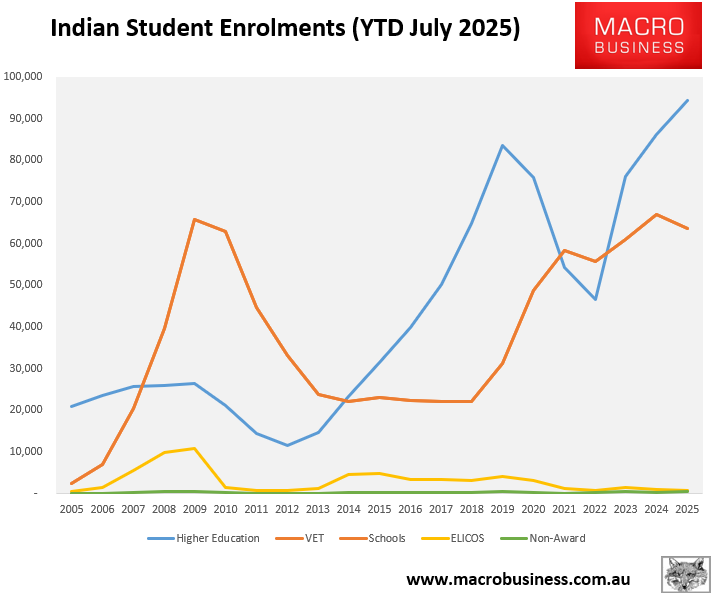India is Australia’s second-largest source of international students.
According to the Department of Education, in the year to July 2025, there were a record 159,530 Indian students enrolled in Australia, up 31,000 from the pre-pandemic peak and 6.6 times more than in 2005:

Of these Indian enrolments, 94,271 were in higher education (universities) and 63,613 were in vocational education and training.

Recent Australian governments have taken direct policy actions to boost Indian student numbers and overall migration, including via the following agreements signed with India:
- The Australia-India Economic Cooperation and Trade Agreement (ECTA), signed by the former Coalition government late in its final term.
- The Australia-India Migration and Mobility Partnership Agreement, signed by the Albanese government in its first term.
- The Mechanism for Mutual Recognition of Qualifications, signed by the Albanese government in its first term.
However, amid concerns of widespread rorting of the visa system by non-genuine students, the former Morrison Coalition government in 2019 deemed students from India, Nepal, and Pakistan “high-risk”, which meant they faced deeper scrutiny when applying for visas from the Department of Home Affairs.
In particular, student applicants from these nations were required to demonstrate they were ‘genuine’ by proving sound English-language proficiency, as well as having adequate funds available to support themselves.
As a result, several Australian educational institutions closed their doors to student applications from India. Even so, student numbers soared to record levels in the post-pandemic period.
On Friday, Indian-Australian news outlet The Australia Today reported that “India’s assessment level for Australian student visas has shifted from Level 3 to Level 2, signalling easier application requirements for Indian students seeking to study Down Under”.
“Key changes include reduced upfront financial evidence and course-dependent English test requirements. Gold Coast–based registered migration agent Seema Chauhan told The Australia Today that this is a positive update for Indian international students seeking high-quality education opportunities in Australia”.
“With India now at Level 2 alongside countries like Bhutan, Vietnam, China, and Nepal, students and families can expect smoother admissions, fewer delays, and greater confidence in pursuing an Australian education”, The Australia Today reported.
Jobs & Skills Australia’s (JSA) latest report on the international education system noted that most international students come to Australia primarily to work and live, rather than for educational purposes.
“Nearly 70% of international higher education students reported that the possibility to migrate was a reason for choosing to study in Australia, rising to 77% of Indian and 79% of Nepali higher education students”, JSA reported.
Moreover, JSA noted that “over 90% of Indian and nearly 96% of Nepali higher education students cited the ability to work while studying as one of the reasons they chose Australia. “80% of students from South and Central Asia (including India and Nepal) were working during study”, JSA said.
Finally, JSA noted that many Indian students send money back to their home countries via remittances.
Clearly, the reduced risk assessments for Indian students will increase the numbers seeking to live and work in Australia.
The Albanese government has opened the Indian student-migration pathway even wider.

